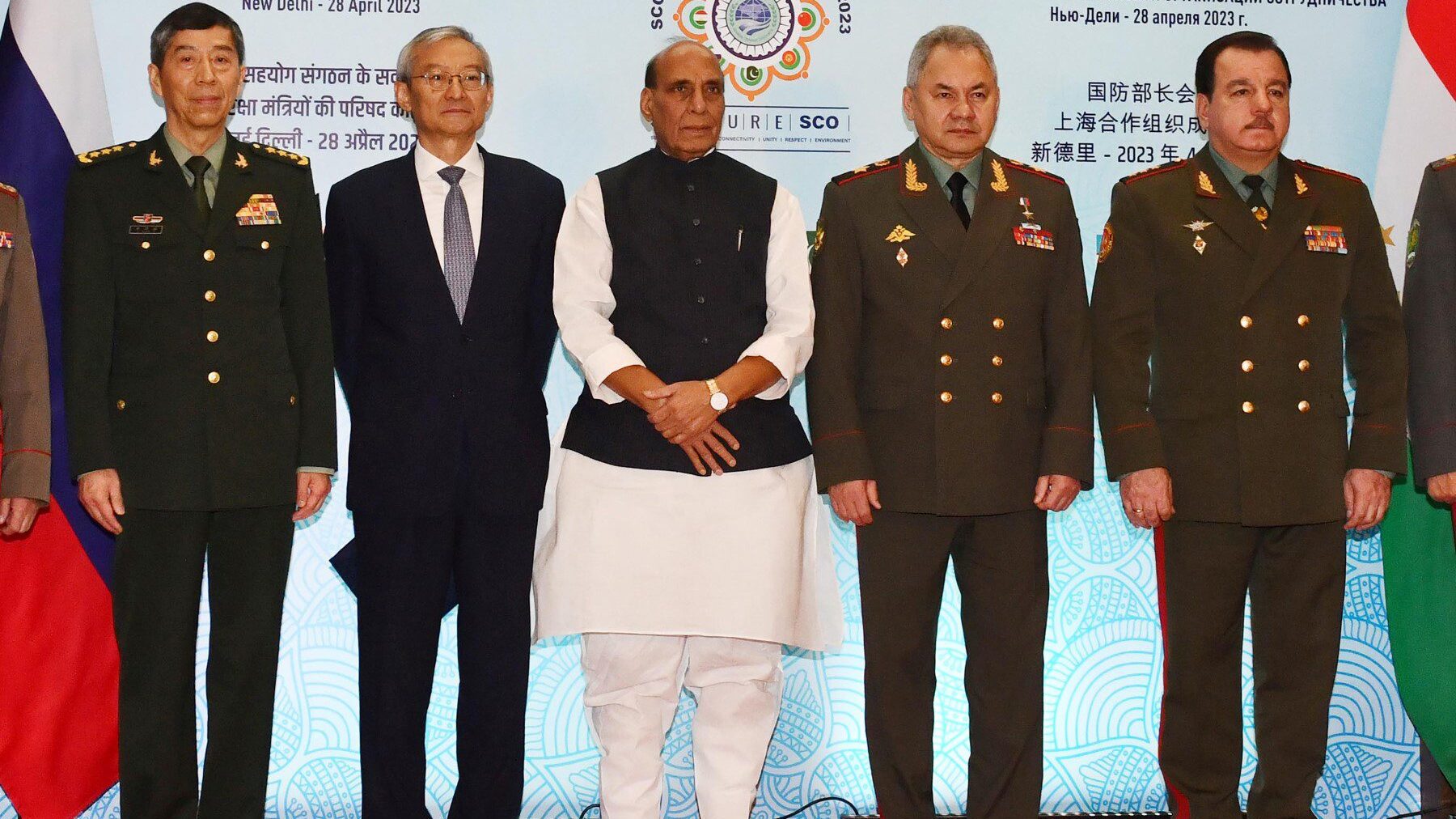
Chinese Defence Minister Li Shangfu, Shanghai Cooperation Organisation (SCO) Secretary-General Zhang Ming, Indian Defence Minister Rajnath Singh, Russian Defence Minister Sergei Shoigu and Tajikistan Defence Minister Sherali Mirzo at a SCO meeting in New Delhi on April 28th, 2023.
ATTR: – / AFP
At the Shanghai Cooperation Organization (SCO) meeting in New Delhi, India, Russian Defense Minister Sergei Shoigu accused the U.S. and its regional allies in the Asia-Pacific of pursuing a containment policy for China.
Speaking to his counterparts from India, China, Kazakhstan, Kyrgyzstan, Pakistan, Tajikistan, and Uzbekistan on Friday, April 28th, Defense Minister Shoigu described how the U.S. is putting “counter-measures” in place to prevent a multipolar world from forming in the Asia-Pacific. The U.S. is able to do this, Shoigu said, through military and political alliances such as QUAD (Australia, India, Japan, and the U.S.) and AUKUS (Australia, the UK, and the U.S.)
While the U.S. promotes the concept of a “free and open” Indo-Pacific, Shoigu said, that position relies on the construction of a “bloc system” in which the Americans “arrogate to themselves the power to determine the norms and rules of behavior.” In order to contain China, he went on, “a front is forming,” which is given added impetus by the “purposeful escalation” of tensions around Taiwan, while territorial disputes in the South China Sea and East China Sea “are being heated.”
Shoigu observed that such a strategy marks a break with what was commonly understood to be a “bloc-free” Asia-Pacific—typified by “equal interaction”—and that this “must be preserved.”
“The existing mechanisms of cooperation with extra-regional partners,” Shoigu went on, “have shown their relevance and effectiveness,” referring to the existing ASEAN (Association of Southeast Asian Nations)-based system of political and economic cooperation, bringing together 10 states in the region.
By challenging that system, Shoigu noted, “Washington and its enablers are pursuing their strategic agenda of provoking other countries into military confrontation with undesirable states, most notably Russia and China.”
He continued to refer to the war in Ukraine as “a clear demonstration of this criminal policy,” the “real aim” of which is “to inflict a strategic defeat on Russia, threaten China, and maintain its [the U.S.’] monopoly position in the world.”
Before the meeting and in between sessions, Shoigu also met with his Chinese counterpart, Li Shangfu. The contents of their talk have however not been disclosed. Not two weeks ago, the two had met in Moscow, with Russian President Vladimir Putin in attendance.
Since India is a member of QUAD (Quadrilateral Security Dialogue), and, given the Russian defense minister’s expressed support for China, New Delhi is bound to have some reservations. Moscow and Beijing’s continued cooperation has already caused concern, while a political resolution of India’s three-year border dispute with China in eastern Ladakh remains elusive.
Ever since India gained its independence, New Delhi has pursued a policy of “strategic autonomy” and considers QUAD (of which the U.S., Australia, and Japan are part) neither a military bloc nor an alliance.
In contrast, AUKUS is a military pact between the U.S., UK, and Australia. In that framework, Australia recently agreed to gradually acquire at least 8 nuclear-powered submarines.
During his meeting with Indian defense minister Rajnath Singh, Shoigu however reaffirmed the long-held strategic partnership between the two countries.
Despite recent pressures on this relationship following Russia’s war in Ukraine—which India refused to condemn—India-Russia ties show no sign of slacking. Indeed, its trade with Moscow has climbed to a record high, in large part due to Russian oil imports.
In a statement released by the Indian government, both parties “acknowledged the unique, long-lasting, and time-tested relationship between India and Russia,” as they “expressed satisfaction over the continued trust and mutual respect,” particularly “in defense,” reiterating their commitment towards “strengthening the partnership.”
As the world’s largest arms importer, India depends on Russia for nearly half of its military supplies; since the war in Ukraine, Moscow’s ability to furnish India with the critical infrastructure needed to maintain its tank and fighter jet fleets has lessened, while the delivery of Russian air defense systems has been delayed.
While India has been diversifying its list of weapons suppliers over the years, Russia still remains its largest, constituting 45% of total imports from 2018-2022.
